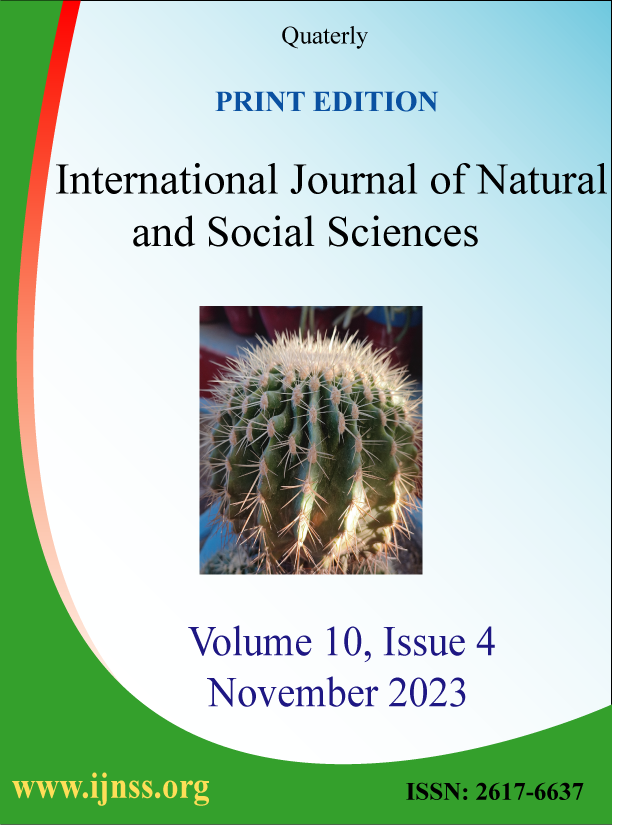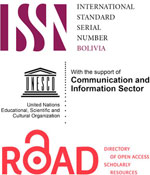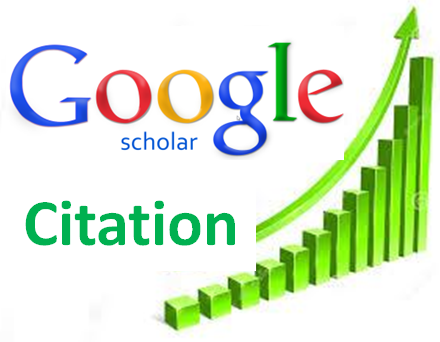Guide for Authors
INTRODUCTION:
Types of contribution
1. Original research papers (Full length article)
Original research papers should report the results of original research. The material should not have been previously published elsewhere, except in a preliminary form.
2. Review articles
Review articles should cover subjects falling within the scope of the journal which are of active current interest. They may be submitted or invited.
3.Rapid Communications
Rapid Communications should contain information of high ‘news’/scientific value worthy of very rapid publication. Rapid Communications should be submitted to the journal as such (i.e. clearly labeled as a RC) and should, in general, not exceed 2000 words in length. Upon receipt, they will be subject to rapid assessment and if accepted, published with priority.
4.Short Communications
Short Communications should consist of original observations or new methods within the scope of the journal. Reports of observations previously published from different geographical areas may be accepted only if considered sufficiently unusual or noteworthy. The Communications should be concise with the minimum of references, and cover no more than four pages of the journal; they need not be formally structured as are full papers, but should give sufficient methods and data necessary for their comprehension.
5. Letters to the Editor
Letters to the Editor offering comment or useful critique on material published in the journal are welcomed. The decision to publish submitted letters rests purely with the Editors-in-Chief. It is hoped that the publication of such letters will permit an exchange of views which will be of benefit to both the journal and its readers.
Conflict of interest
The first author is requested to declare any actual or potential conflict of interest including any financial, personal or other relationships with other people or organizations within three years of beginning the submitted work that could inappropriately influence, or be perceived to influence, their work. Please include this under a heading “Conflict of interest statement” at the end of the text.
Submission declaration
Submission of an article (by email or by post with soft copies) implies that the work described has not been published previously (except in the form of an abstract or as part of a published lecture or academic thesis or as an electronic preprint). If accepted, it will not be published elsewhere including electronically in the same form, in English or in any other language, without the written consent of the copyright-holder.
Authorship
All authors should have made substantial contributions to all of the following: (1) the conception and design of the study, or acquisition of data, or analysis and interpretation of data, (2) drafting the article or revising it critically for important intellectual content, (3) final approval of the version to be submitted.
Changes to authorship
This policy concerns the addition, deletion, or rearrangement of author names in the authorship of accepted manuscripts:
Before the accepted manuscript is published in an online issue: Requests to add or remove an author, or to rearrange the author names, must be sent to the Journal Manager from the corresponding author of the accepted manuscript and must include: (a) the reason the name should be added or removed, or the author names rearranged and (b) written confirmation (e-mail, fax, letter) from first author that he /she agrees with the addition, removal or rearrangement.
Note that: (1) Journal Managers will inform the Journal Editors of any such requests and (2) publication of the accepted manuscript in an online issue is suspended until authorship has been agreed.
After the accepted manuscript is published in an online issue: Any requests to add, delete, or rearrange author names in an article published in an online issue will follow the same policies as noted above and result in a corrigendum.
Plagiarism
Submitted manuscript to IJNSS should be original works from the author worldwide. The plagiarised materials/manuscript/article/data cannot be considered for publication, while plagiarism of any type will incur sanctions against all author of submitted manuscript/article/materials/data. RALF publisher reserve the right to impose sanctions in case of plagiarism and the plagiarised manuscript will be immediately rejected or removed from the website or link will provided to the original sources.
Copyright permission and approval
The corresponding author is required to obtain the necessary permission of texts, passages, tables, figures/illustrations and artworks published previously elsewhere from
the copyright owners at the time of manuscript submission. The journal editor/publisher do not held responsible legally for any claims and compensations. The proof of permission and approval is to be submitted for accepted article before final publication..
Language (usage and editing services)
Please write your text in good English (American or British usage is accepted, but not a mixture of these).
PREPARATION OF MANUSCRIPT
Prepare your manuscript in Microsoft word. The text should be in single-column format. Keep the layout of the text as simple as possible. Most formatting codes will be removed and replaced on processing the article. Do use bold face, italics, subscripts, superscripts etc. When preparing tables, if you are using a table grid, use only one grid for each individual table and not a grid for each row. If no grid is used, use tabs, not spaces, to align columns. The electronic text should be prepared in a way very similar to that of conventional manuscripts. Note that source files of figures, tables and text graphics will be required whether or not you embed your figures in the text. See also the section on Electronic artwork.
To avoid unnecessary errors you are strongly advised to use the ‘spell-check’ and ‘grammar-check’ functions of your word processor.
Article structure
Manuscripts in general should be organized in the following order:
Title (should be clear, descriptive and not too long)
Name(s) of author(s)
Complete postal address(es) of affiliations
Full telephone, Fax No. and e-mail address of the corresponding author
Present address(es) of author(s) if applicable
Complete correspondence address including e-mail address to which the proofs should be sent
Abstract
Keywords (indexing terms), normally 3-6 items. Please refer to last index (Vol. 100/3-4).
Introduction
Material and Methods
Results and Discussion
Acknowledgments and any additional information concerning research grants, etc.
References
Tables
Figure captions
Titles and subtitles should not be run within the text. They should be typed on a separate line, without indentation. SI units should be used. Divide your article into clearly defined sections with bold text. Subsections should be italic
Abstract
The abstract should be clear, descriptive and not more than 400 words
Abbreviations
Define abbreviations that are not standard in this field in a footnote to be placed on the first page of the article. Such abbreviations that are unavoidable in the abstract must be defined at their first mention there, as well as in the footnote. Ensure consistency of abbreviations throughout the article.
Acknowledgements
Collate acknowledgements in a separate section at the end of the article before the references and do not, therefore, include them on the title page, as a footnote to the title or otherwise. List here those individuals who provided help during the research (e.g., providing language help, writing assistance or proof reading the article, etc.)
Artwork
General points
- Make sure you use uniform lettering and sizing of your original artwork.
- Embed the used fonts if the application provides that option.
- Aim to use the following fonts in your illustrations: Times New Roman, Arial, Courier, Symbol, or use fonts that look similar.
- Number the illustrations according to their sequence in the text.
- Use a logical naming convention for your artwork files.
- Provide captions to illustrations separately.
- Size the illustrations close to the desired dimensions of the printed version.
- Submit each illustration as a separate file.
Tables
- Authors should take notice of the limitations set by the size and lay-out of the journal. Large tables should be avoided. Reversing columns and rows will often reduce the dimensions of a table.
- If many data are to be presented, an attempt should be made to divide them over two or more tables.
- Tables should be numbered according to their sequence in the text. The text should include references to all tables.
- Each table should occupy a separate page of the manuscript. Tables should never be included in the text.
- Each table should have a brief and self-explanatory title.
- Column headings should be brief, but sufficiently explanatory. Standard abbreviations of units of measurement should be added between parentheses.
- Vertical lines should not be used to separate columns. Leave some extra space between the columns instead.
- Any explanation essential to the understanding of the table should be given as a footnote at the bottom of the table
References
Citation in text
Please ensure that every reference cited in the text is also present in the reference list (and vice versa). Any references cited in the abstract must be given in full. Unpublished results and personal communications are not recommended in the reference list, but may be mentioned in the text. If these references are included in the reference list they should follow the standard reference style of the journal and should include a substitution of the publication date with either ‘Unpublished results’ or ‘Personal communication’. Citation of a reference as ‘in press’ implies that the item has been accepted for publication.
Reference Style
1. All publications cited in the text should be presented in a list of references following the text of the manuscript. The manuscript should be carefully checked to ensure that the spelling of author’s names and dates are exactly the same in the text as in the reference list.
2. In the text refer to the author’s name (without initial) and year of publication, followed – if necessary – by a short reference to appropriate pages. Examples: “Abdur Rahman (1998) has shown that.” “This is in agreement with results obtained later (Kramer, 1989)”.
3. If reference is made in the text to a publication written by more than two authors the name of the first author should be used followed by “et al.”. This indication, however, should never be used in the list of references. In this list names of first author and co-authors should be mentioned.
4. References cited together in the text should be arranged chronologically. The list of references should be arranged alphabetically on author’s names, and chronologically per author. If an author’s name in the list is also mentioned with co-authors the following order should be used: publications of the single author, arranged according to publication dates – publications of the same author with one co-author – publications of the author with more than one co-author. Publications by the same author(s) in the same year should be listed as 1974a, 1974b, etc.
5. Use the following system for arranging your references:
a) For periodicals
Mostafa M, Mc Kellar QA and Alam MN (1996). Epidemiology of gastrointestinal helminth parasites in small ruminants in Bangladesh. ACAIR Publication, Australia, 74:105-108.
b) For books
Blood DC and Radostits OM (1989). Veterinary Medicine. 7th edn. Balliere and Tindal, London
c) For multi-author books
Wilson MB, Nakane PK (1978). Recent developments in the periodate method of conjugating horseradish peroxidase (HRPO) to antibodies. In: Knapp, W., Holubar, K., Wick, G. (Eds.), Immunofluorescence and Related Staining Techniques. North Holland, Amsterdam, 215–224.
6. Work accepted for publication but not yet published should be referred to as “in press”.
7. References concerning unpublished data and “personal communications” should not be cited in the reference list but may be mentioned in the text.
8. Web references may be given. As a minimum, the full URL is necessary. Any further information, such as Author names, dates, reference to a source publication and so on, should also be given.
9. Articles available online but without volume and page numbers may be referred to by means of their Digital Object identifier (DOI) code.
Supplementary data
Provide your research supplementary materials that will definitely support and enhance your scientific research. Supplementary files supplied will be published online alongside the electronic version of your article in journal website.
Online proof correction
Corresponding authors will receive an e-mail with the revised manuscript for required correction.
Publication fee
IJNSS is an Open Access Journals where subscriptions and pay-per-view fees are not necessary, hence enabling readers to access research at no cost. To keep the publication sustainable, the publisher applies an Article Processing Charge to cover the costs of the editorial workflow and production, such as the cost of reviewing, editorial management, online publication and journals’ website maintenance.
For article having 1st author inside Bangladesh, the fee is Tk. 3500 (Three Thousand and Five Hundred Taka only). The article having 1st author outside Bangladesh the fee is US $ 70.
Payment method:
Bank Payment Method:
1. Within Bangladesh:
Account Name: MD. SHAHIDUZZAMAN
Account Number: 141101172786
Bank Name: PUBALI BANK LIMITED
Routing No. 175612415
University Campus Branch
Swift Code: PUBABDDH
Or
Alternate Methods:
bKash (Including Cash out Charge)
Md. Shahiduzzaman (Editor)
Cell No.: +880-1716460558 (Personal Number)
2. From outside Bangladesh
Bank transfer, Money Gram, Western Union to Editor of the journal as below-
Name : MD SHAHIDUZZAMAN
City: Mymensingh; Code- 2202
Country: Bangladesh
For any query please contact to: editor.nssjournal@gmail.com






